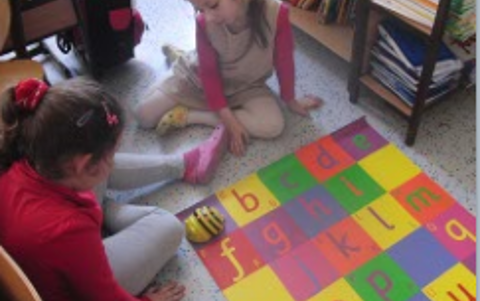Spelling bee

About this lesson
Write a set of instructions that program a Bee-Bot to move to letters to spell out a word on an alphabet grid.
Year band: 1-2
Curriculum Links AssessmentCurriculum Links
Links with Digital Technologies Curriculum Area
| Strand | Content Description |
|---|---|
| Processes and Production Skills | Follow and describe algorithms involving a sequence of steps, branching (decisions) and iteration (repetition) (AC9TDI2P02) |
Links with Mathematics Curriculum Area
| Strand | Content Description |
|---|---|
| Space |
Describe the position and location of themselves and objects in relation to other people and objects within a familiar space (AC9MFSP02) Give and follow directions to move people and objects to different locations within a space (AC9M1SP02) Locate positions in two-dimensional representations of a familiar space; move positions by following directions and pathways (AC9M2SP02) |
Links with English Curriculum Area
| Strand | Content Description |
|---|---|
| Phonic and word knowledge |
Read and write some high-frequency words and other familiar words (AC9EFLY14) Read and write an increasing number of high-frequency words (AC9E1LY14) Use knowledge of spelling patterns and morphemes to read and write words whose spelling is not completely predictable from their sounds, including high-frequency words (AC9E2LY11) |
ICT Capability
Typically, by the end of Year 2, students:
Select and use hardware and software
- Identify and safely operate a selected range of appropriate devices, software, functions and commands when operating an ICT system and attempt to solve a problem before seeking help
Assessment
Teacher assessment
Use a simple checklist to evaluate achievement.
Can the student:
- describe the functions of the Bee-Bot?
- design a correct sequence of instructions?
- select the appropriate buttons that will program a Bee-Bot to follow a simple path?
- describe the purpose of programming a Bee-Bot?
- use directional language correctly?
Suggested steps
- Provide students with a list of words (spelling-list words; high-frequency words; words with regular spelling patterns).
- Working in pairs, students design a course to ensure the Bee-Bot moves to each letter in sequence, with the aim of correctly spelling one of the words on the list. Students can design the letter path using directional words, numbers or arrows.
- After designing the course, students program the Bee-Bot to follow the route.
Discussion
- Consider the factors that led to success or failure. Emphasise the importance of clear and precise instructions.
- Ask and then discuss why it is important to test and retest programs.
- Discuss how it is that different paths/courses can lead to the same outcome. Compare the different paths used to spell the same word. What path would the Bee-Bot take if it was in a hurry?
Why is this relevant?
This activity is an authentic way to introduce students to simple programming while consolidating spelling concepts. It focuses on developing foundational skills in computational thinking, and on developing an awareness of digital systems through personal experience of them.
Students in F–2 should be provided with opportunities to explore new concepts such as algorithms through guided play, including hands-on, kinaesthetic and interactive learning experiences. Students begin to develop their design skills by conceptualising algorithms as a sequence of steps or procedures for carrying out instructions to solve problems or achieve certain things, such as identifying steps in a process or controlling a Bee-Bot.
At the F–2 level, where learning at the pre-programming stage is the expectation, there is no requirement to learn a particular programming language. However, students do learn some basic programming skills such as working out steps and decisions required to solve simple problems. For example, they program a robotic toy to move in a certain direction. The focus at this level is on designing a sequence of steps.